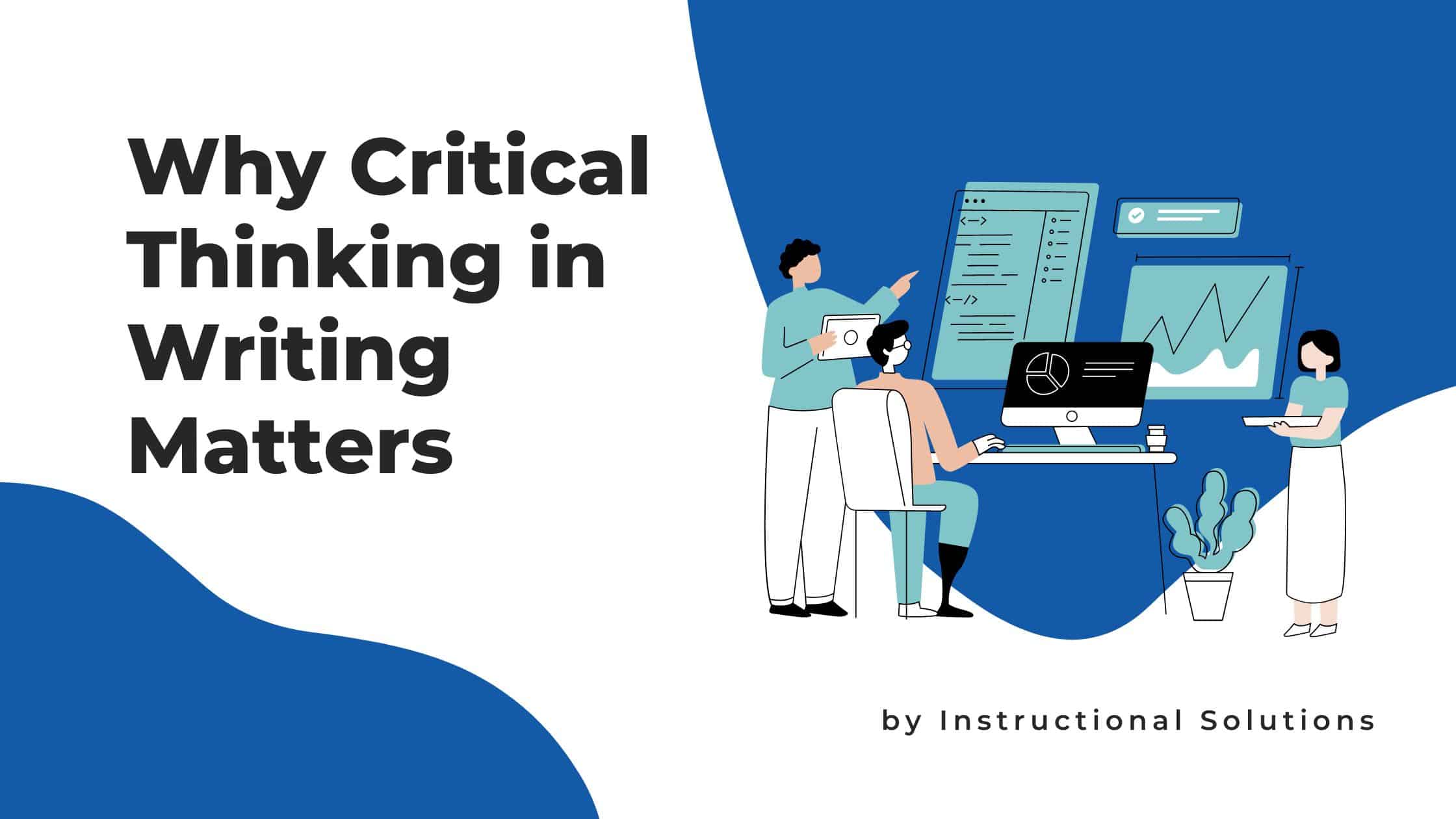Critical Thinking in Writing: Why Does It Matter for Professionals?

Writing with AI - Learn more


Critical Thinking in Writing involves reflective and independent thinking. It utilizes reasoning skills to learn rather than relying on opinion. It is a core lesson taught in all of our business writing courses.
Critical thinking involves questioning ideas and assumptions to develop clear and strong points for consideration. It involves seeking a complete understanding of ideas, arguments, and findings and being open to the possibility of incomplete information. Critical thinkers approach problem-solving in a systematic rather than intuitive or instinctive manner.
When professionals present well-researched content, readers are invited to analyze the information for themselves in an unbiased way. This blog will explain how critical thinking in writing can massively improve your communications by helping you think clearly and make stronger points.
Critical thinking is a fundamental life skill that plays an important role in all areas of our lives. It is thoughtful and reflective. Rather than forming quick judgments based on bias, opinion, or emotion, critical thinkers are equipped to ask important questions that enable people to look at multiple sides of nuanced issues. By covering all aspects of a topic, critical thinking helps individuals make decisions that are more informed and well-considered.
Critical thinking at work enables individuals to gain knowledge of important information related to their organization. It allows for decision-making that benefits the individual, others, and society. As a writer in any role, merely possessing knowledge in a specific field is often insufficient. Using critical thinking in business writing moves beyond personal experience and creates well-researched and correct information that is required in the workplace.
Applying critical thinking skills in writing will help you make massive improvements. We like to say that good writing is predicated upon good critical thinking. There are innumerable benefits, but here are some of the key ones:
Critical thinking encourages curiosity. This pushes individuals to dive deeper, challenge assumptions, and explore alternative perspectives, resulting in richer, more nuanced, and captivating writing.
Critical thinking enhances creativity. You may need to consider a variety of viewpoints. This may take some out-of-the-box thinking when presenting bad news, giving a presentation, sending a final project report to executives, etc.
Critical thinking skills reinforce problem-solving. Experienced writers who possess critical thinking skills often demonstrate natural problem-solving abilities and are able to dissect complex issues and generate innovative solutions. Their ability to analyze information enables them to deliver well-reasoned and insightful written content.
Critical thinking is a multi-faceted practice. Writing assignments will encompass a wide range of disciplines, including reasoning and analytical skills. By actively engaging in critical thinking during the writing process, professionals can cultivate a versatile skill set that goes beyond the limits of their specific role, allowing them to tackle diverse writing assignments.
When critical thinking in writing is lacking, the quality of the information you present can suffer greatly. Not applying this important skill leads to issues that are easy to detect. One sign your writing lacks critical thinking is the lack of meaningful relationships between concepts. Ideas and arguments won't connect to each other, and readers will find your content is limited or disjointed.
Repetition is particularly damaging when points don't fit into the main points of a brief. Readers may lose patience quickly if they don’t clearly see how authors are leading them toward their conclusions.
Before applying critical thinking in your writing, it is essential to understand how to systematically analyze information and assess evidence. Developing strong critical thinking skills in writing helps ensure your arguments are well-reasoned, accurate, and compelling, allowing you to communicate effectively in any professional context.
When it comes to any research and critical analysis you may have to do, questioning everything is paramount. Sources could be inaccurate or irrelevant, so it’s important to be wary. Thinking (and reading) critically requires you to stay alert when assimilating and using data for a professional document. Asking even the most basic questions can help determine the validity. To ensure accuracy, one has to carefully vet all gathered material, question the veracity of any sources, validate the data, and only then begin the process of analysis.
In addition to considering where the source material comes from, it is equally important to identify and assess its credibility. Strive for valid and verifiable data and include accurate facts and figures in your writing. It is also essential to take into account any bias present in the source materials while confirming its accuracy with other reliable sources. As an example, if you're presenting research for new project management software, reading reviews or testing the software yourself may be helpful rather than relying solely on the promises the software's website makes. Reliable information should typically be verifiable across multiple sources.
When it comes to making decisions or presenting an argument, staying true to the evidence is essential. Good critical thinking and research skills are necessary for any situation in which one needs to come up with a valid conclusion. Evidence helps writers view topics objectively. Review the facts before leaping into a subjective opinion. When interpreting evidence, do not focus only on what supports your position. Look at all perspectives and consider how they might shape your own conclusion. Evaluate how different elements of the evidence interplay with each other and how this ultimately plays into your overall message.
A truism is a statement that is universally accepted to be true, while a tautology is an idea or phrase which repeats the same thing. Using them can cause writing to become redundant. Filler adds nothing to the content and may distract the reader. These can often be found in thesis statements or executive summaries.
Oversimplification, when a complex topic is presented without proper explanation or context, is a serious issue that can lead to misunderstanding. It may even leave readers feeling patronized and frustrated with your content. Whenever possible, it is important to provide more depth instead of presenting vague details without offering any further explanation.
Even when limited by word count, accuracy should never be compromised. Present your fact-based narrative in a way that strengthens clarity and never underestimates or assumes the knowledge of your audience.
In addition to evaluating resources, it is also important to have an organizational strategy. Present each piece of evidence in the most effective way possible so your writing is not misinterpreted. An outline or content map for organizing your document can help keep your writing coherent and maintain clarity throughout.

Parsing through and breaking down the text from various perspectives can help you refine your critical thinking in writing. Here are some great strategies:
Priority ranking is a useful tool for breaking down content into easy-to-understand parts. By assigning an order to your content, you can decide which points will be more important or impactful, giving them more focus in professional writing. This also helps in keeping the document's structure logical while avoiding introducing irrelevant facts that may divert attention from the main point.
Comparison and contrast sections assist readers in fully understanding your argument by outlining similarities and differences between two sets of ideas, providing more detailed evidence and explanation to your readers. For example, you can explain how A is different from B in terms of their overall impacts. Like priority ranking, this helps readers better understand the argumentative relationships between different ideas as well as highlight the reasoning (or critical thinking) behind your conclusion.
Cause and effect methods of breaking down information are useful for finding out what leads to a situation or an occurrence. Explaining the direct connection between two events provides insight into why one thing happened over another. This is especially useful in report writing. In addition, making inferences about complex thoughts or statements gives readers a clearer picture of exactly why certain points were considered when coming up with final judgments on an issue.
The significance of critical thinking in writing cannot be overstated for professionals in any field. It serves as the foundation for effective communication, enabling you to express your thoughts clearly, persuasively, and logically. By honing critical thinking skills, you can analyze complex information, identify biases and fallacies, and formulate well-reasoned arguments.
Moreover, critical thinking empowers individuals to challenge conventional wisdom, question assumptions, and seek innovative solutions to problems. Since the information in today's world is abundant yet often misleading, the ability to think critically and communicate effectively is a valuable asset that sets professionals apart.
Our online, virtual, and in-person courses include detailed written feedback on your actual writing.
View Courses & OutlinesWhen we are asked to demonstrate critical thinking in our writing, it requires us to go beyond summarizing facts or simply providing our personal opinion on the matter. Critical thinking involves questioning assumptions and recognizing the underlying implications of the material being discussed or studied. We must present arguments based on facts backed by evidence rather than relying on vague generalizations or opinions as well as consider multiple perspectives.
To facilitate this, our research should be comprehensive enough to cover all relevant topics while also excluding any unnecessary distracting information. Once these steps have been taken, we can present logical conclusions following reasonable paths of thought that support our academic argument.
When you are writing critically, you are persuading the reader of your position on something, whereas when you are writing descriptively, you are informing them of something you have read, observed, or done.
Descriptive writing aims to provide a detailed description of a person, place, object, event, or concept. Its primary goal is to paint a picture to the audience, creating a clear understanding of what is being described. This is often used in creative or academic writing.
Critical writing involves analyzing, evaluating, and providing a thoughtful assessment or judgment of a subject, such as a journal article, book, artwork, theory, or any other intellectual piece of writing. The aim of critical writing is to critically engage with ideas, arguments, and evidence, offering a balanced evaluation based on logical reasoning and evidence. This is always the type of writing being used in a professional setting, especially in technical writing.
Critical thinking is important in both business writing and academic writing, and yes, there is a difference. In business writing, critical thinking helps professionals analyze data, assess risks, and make informed decisions. In academic writing, it is essential for evaluating sources, constructing arguments, and engaging in scholarly discourse.
